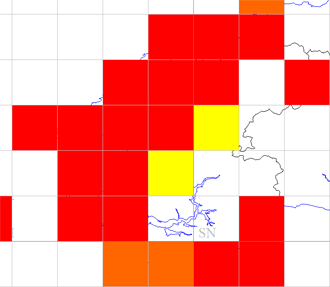Peregrine - 2003-07
 Monday, May 7, 2012 at 4:49PM
Monday, May 7, 2012 at 4:49PM Most of what we know about Peregrines in the county is due to a small but dedicated band of volunteers who undertake the leg-work. Assessing the total Peregrine population in any one year requires a reasonable amount of effort and knowledge of the particular “patch”. They can utilise alternative nest sites over quite long stretches of coast. So it usually takes quite a few field-recording hours, often involving long walks along the coast path, to prove territory occupancy and confirm breeding. Detailed recording close to the nest also requires experienced, licensed observers.
Approximately every 10 years the entire UK population is surveyed to assess changes at the national level. The breeding population in Pembrokeshire has been subjected to annual surveillance since the early 1960s, coordinated by Jack Donovan up to 1983 and by Bob Haycock since then.
By the time of the first (1984-88) Pembrokeshire breeding birds atlas fieldwork period, the Peregrine breeding population was recovering well in the county. Some 14 – 15 breeding pairs were recorded by 1983 and by the end of the atlas period they had been found in 51 tetrads. By 1991, 39 territories were known to be occupied and their numbers had recovered to at least pre-second World War levels.
Between 2003 and 2007, the total number of tetrads in which Peregrines were found had risen to 69, an increase of about 35%. Annual surveillance of the breeding population recorded 43 – 49 confirmed occupied territories, about three times the number recorded in the mid 1980s.
In the mid-1980s, all but two occupied territories were on the coast. By 2003 - 07 the number breeding inland, at quarries or other man-made sites such as large industrial structures (oil refinery and power station buildings - the latter now demolished), had risen to eight and they had been recorded in the breeding season from at least 14 inland tetrads.
The breeding population appears now to have stabilised (see figure 3 below of population trends), although the trend towards inland breeding may still be growing. In some places, inland sites may be seasonal alternatives to coastal sites.
There are still threats to the population; sporadic incidents of persecution still occur, including fairly recent evidence of individual birds either being shot or poisoned, or of individual nests being disturbed.
Bob Haycock

Fieldwork 2003-07 (based on 490 tetrads)
Red = breeding confirmed
Orange = breeding probable
Yellow = breeding possible
Tetrads in which found = 69 (14.1%)
 PBBA 2003-7,
PBBA 2003-7,  RJH in
RJH in  Peregrine
Peregrine 

Reader Comments